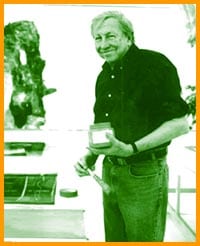Robert Rauschenberg, once dubbed the “art world’s master joker,” is coming to Toronto next week as one of many luminaries being honoured at Harbourfront Centre’s World Leaders: A Festival Of Creative Genius.
Throughout his varied career of more than 50 years, Rauschenberg has always taken photographs. Seventy-five of them, a small slice of his prodigious output, are now showing in In + Out City Limits at the York Quay Gallery (235 Queens Quay W).
The photographs are testament to Rauschenberg’s legendary and wide-ranging curiosity and his eye for the idiosyncratic. Early on he discovered what the Dadaists and his mentor Marcel Duchamp knew: Art can be made from the discarded, from found objects.
Duchamp himself made what he called “ready-mades,” the most famous of which was a urinal that he signed “R Mutt.”
Rauschenberg took this practice further and made “combines” with the objects he collected, a mix of painting, sculpture and collage, which stood in cheeky opposition to the ego and formalism of painters like Jackson Pollock and Mark Rothko.
Rauschenberg’s combines gave this quietly gay artist prominence in the late 1950s. One of them, Monogram 1955-59, a stuffed angora goat with a tire encircling its middle on a wide patchwork-painted wooden pedestal, was described by critic Robert Hughes as “one of the few great icons of male homosexual love in modern culture.”
Rauschenberg enthusiastically demonstrated that you could make your own rules, that concept could drive artwork more than form. Art historian Robert Rosenblum remarked: “Every artist after 1960 who challenged the restrictions of painting and sculpture and believed that all of life was open to art is indebted to Rauschenberg.”
His house rule in the ’50s was to make art on any given day with whatever he could collect on a walk around his block. The photography show is, in fact, the photographic equivalent of a Rauschenberg walk around the block, and I could easily imagine him roaming, eye glued to his camera’s viewfinder. But in this case, his “block” was not limited to one neighbourhood, but opened to the globe.
Back in 1951 Rauschenberg declared that he would photograph the United States “foot by foot” and “inch by inch.” Over his career, his photo “addiction,” as he once put it, took him to New York, Atlantic City, Baltimore, Charleston, Savannah, Fort Meyers and to a dozen other countries.
The York Quay Gallery show comprises works from all this intense photo activity. Needless to say, it covers a lot of ground. I’m sure curator Linda Belshaw Beatty had a hard time deciding which images would make the cut.
While many of the black and white photographs carry a charm, they nonetheless truck too heavily in a visual language practiced to greater effect by many other notable photographers: André Kertész, Walker Evans, Robert Frank, Lee Friedlander or Garry Winogrand.
I also couldn’t escape the impression that the photographs served more as visual fact-finding. And as one of my art school instructors once remarked: “Not every moment of perception is interesting.” Not every photograph of Rauschenberg’s is interesting. Many reward a second look with a clever and unlikely juxtaposition, and a few are exceptional. These are worth the trip.
The photographs from the’50s are particularly good. Most are portraits of his art pack: painter Cy Twombly, choreographer Merce Cunningham and musician David Tudor (composer John Cage is oddly absent). They are in their prime, they love life – and possibly each other – and the resulting images are somehow less forced and, paradoxically, more artful.
Twombly stands in profile beside an enormous relic, a hand pointing to the sky, in Rome. There is Cunningham, crouching, arms outstretched, slightly blurred, a vibrant energy caught on film. A man sits on the floor of a room in Tangiers, a telephone just beyond the hand on which he leans, light flooding through a window at the top of the frame.
In the end, In + Out City Limits gives us another facet of Rauschenberg’s practice but not greater insight into his indisputable genius.
Fuse, on the other hand, an ancillary show in the Case Studies corridor outside York Quay Gallery, does. The vitrines hold homages to Rauschenberg by eight local artists such as John Dickson, Fastwürms and Rebecca Diederichs. These works are full of unlikely objects and zany juxtapositions, and more completely reflect a Rauschenbergian energy and irreverence.
IN + OUT CITY LIMITS/FUSE.
Till Sun, Nov 4.
York Quay Gallery.
235 Queens Quay W.
(416) 973-3000.
Robert Rauschenberg’s homage at the World Leaders fest begins at 6pm on Mon, Oct 15 at The Liberty Grand (25 British Columbia Rd). The evening includes a multi-media stage production and special culinary delights. Tickets are $175; call (416) 973-4000. Info about related lectures and other events is at www.worldleadersfestival.com.

 Why you can trust Xtra
Why you can trust Xtra


